“Just give us a second…we’re a little backed up right now.”
You’ve said it. Maybe more times than you’d like. It’s a phrase that slips out during peak hours. Not because your team isn’t trying, but because your setup can only do so much. Self-service kiosks fix that. They speed things up without adding to your payroll.
This guide shows you what they cost, how they work, and how to choose the right one for your store, restaurant, or service counter.
What Is a Self-Service Kiosk and Why Are Businesses Investing?
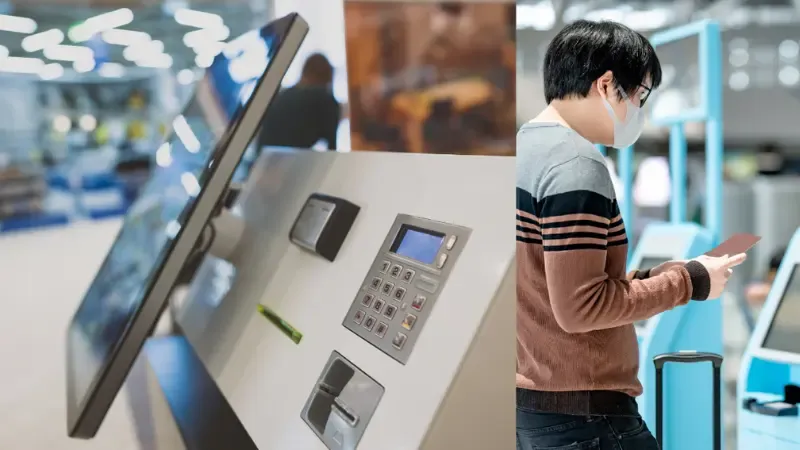
Self-service kiosks are a smarter fix for operational bottlenecks.
It’s like a pressure valve, relieving stress for overloaded teams. It handles high-volume, low-complexity tasks that typically slow down your frontline staff.
Instead of waiting for assistance, customers interact with the system directly. They place orders, make payments, check in, or find information independently.
For many businesses, kiosks are a necessity. They use kiosks to reduce labor costs, fill staffing gaps, and meet customer demand for faster, frictionless service.
Different Models Use Different Types of Kiosks
Self-Checkout Kiosks (Retail and Grocery Stores)
Use self-service kiosks to speed up checkouts, reduce lines, and free up staff for restocking and customer service.
Self-Ordering Kiosks (Restaurants and Cafés)
Let diners place and pay for orders on-screen, which reduces wait times and order mistakes.
Information Kiosks (Hotels, Clinics, and Public Offices)
Rely on kiosks for self-check-in, appointment confirmation, and form filling.
Payment Kiosks (Transportation and Ticketed Venues)
Use kiosks to issue tickets, accept payments, and handle last-minute changes without clogging up service counters.
Why Business Owners Are Paying Attention
A kiosk fills the exact gap where speed and consistency matter most…and where adding more staff doesn’t always make financial sense. That’s why business owners are choosing kiosks not to modernize, but to stay operational and profitable under pressure.
How Much Does a Self-Service Kiosk Cost?

The price of a self-service kiosk depends on what you need it to do and how much customization you require.
Entry-level models cost a few thousand dollars, while advanced systems can go well over $15,000. Understanding the cost structure upfront helps you plan realistically and avoid budget surprises.
Average Pricing by Kiosk Type
Different kiosk types come with different components, functions, and use cases. Here’s a practical breakdown to help you compare the average cost range based on your business model.
| Kiosk Type | Average Cost Range | Common Features |
|---|---|---|
| Self-Checkout | $5,000–$20,000 | Barcode scanner, touchscreen, receipt printer, card reader, POS integration |
| Self-Ordering | $3,000–$10,000 | Menu interface, payment module, thermal printer, customer display |
| Information Kiosk | $2,500–$7,000 | Interactive display, content management software, wayfinding, or FAQ interface |
| Ticketing Kiosk | $4,000–$15,000 | Payment system, ticket printer, barcode reader, optional cash acceptance |
Prices vary depending on the level of hardware, software, and integration needed.
Key Cost Drivers to Consider
Here are the major cost drivers that affect the overall pricing;
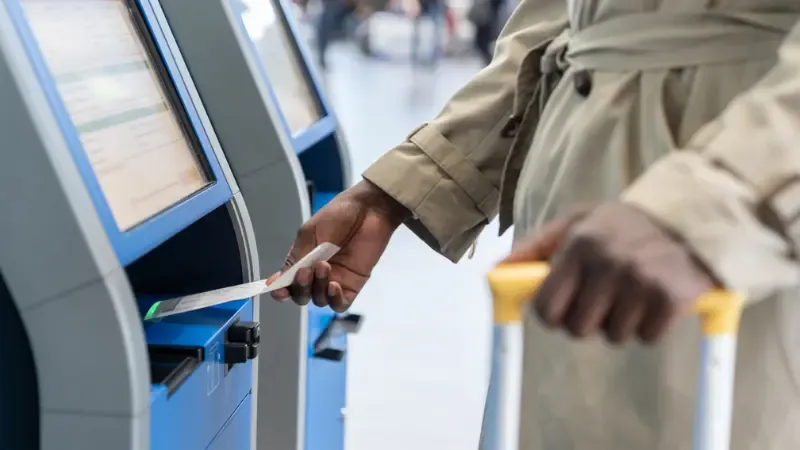
- Hardware
Touchscreens, processors, printers, card readers, barcode scanners, and housing material all impact base pricing.
- Software Licensing
Some kiosks run on licensed platforms with monthly or annual fees. Others may require a one-time software purchase or a custom build.
- Customization
If you need branding, custom UI, or system integration (e.g. with your POS, CRM, or inventory), development costs increase.
- Installation and Setup
Expect additional costs for shipping, physical installation, and on-site configuration.
- Ongoing Support
Many providers charge for software updates, security patches, and remote or in-person tech support. Some offer support plans, others bill per visit or incident.
Self-Checkout Kiosk Cost vs. Traditional Checkout Costs
To make a smart investment decision, you need to compare what kiosks replace…not just what they cost. Here’s how self-checkout kiosks stack up against traditional manned checkout counters in four key areas: speed, labor, customer experience, and transaction security.
| Feature | Self-Checkout Kiosk | Traditional Checkout Counter |
|---|---|---|
| Speed | Instant payment processing; no delay | Slower during busy periods; reliant on staff |
| Labor Cost | Replaces or reduces cashier hours | Requires dedicated cashiers |
| Customer Experience | Gives users more control and faster service | Often involves waiting in line |
| Security | Encrypted card payments and digital logs | Prone to human error and cash discrepancies |
For high-traffic businesses, the labor cost savings and service speed from kiosks often outweigh the upfront investment within months.
And once the system is in place, the cost per transaction drops while service quality remains consistent.
Cost vs ROI: Are Self-Service Kiosks Worth the Investment?
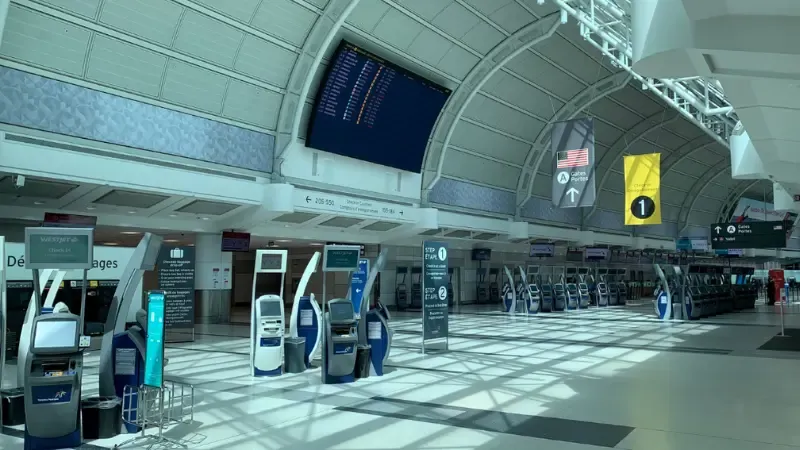
A self-service kiosk can cost several thousand dollars up front, but the return often comes faster than most business owners expect.
The real value shows up in daily operations…where time, labor, and sales make the biggest difference.
Labor Savings Add Up Quickly
With fewer cashiers or front-desk staff required, you reduce payroll without cutting service. If you save just $2,500 a month in wages, a $10,000 kiosk pays for itself in four months. After that, it becomes a profit tool, not just an expense.
Faster Service = Higher Throughput
A kiosk processes orders or payments without slowing down. No breaks, no delays, no lines waiting on a distracted cashier.
- Retail: Customers scan and pay on their own
- Restaurants: Orders go straight to the kitchen
- Clinics and hotels: Guests check in without a receptionist
Speed increases capacity, and more transactions mean more revenue.
Better Experience Brings People Back
Customers prefer control, speed, and fewer touchpoints. Kiosks give them all three. When service feels smoother, people spend more…and return more often.
Extra Value You Don’t Always Track
A kiosk does more than process orders. It can prompt upsells automatically, collect customer feedback, and run targeted promotions.
- Built-in upsell prompts (“Add fries?” “Upgrade to premium?”)
- Data collection from every transaction
- 24/7 availability without hiring night staff
These add-ons boost sales, improve marketing, and help you make smarter business decisions over time.
Benefits of Self-Service Kiosks for Both Businesses and Customers
Kiosks are solving deeper issues that impact both your bottom line and customer satisfaction.
Here’s how self-service technology creates value on both sides of the counter.
Business Benefits (Efficiency, Savings, and Better Control)
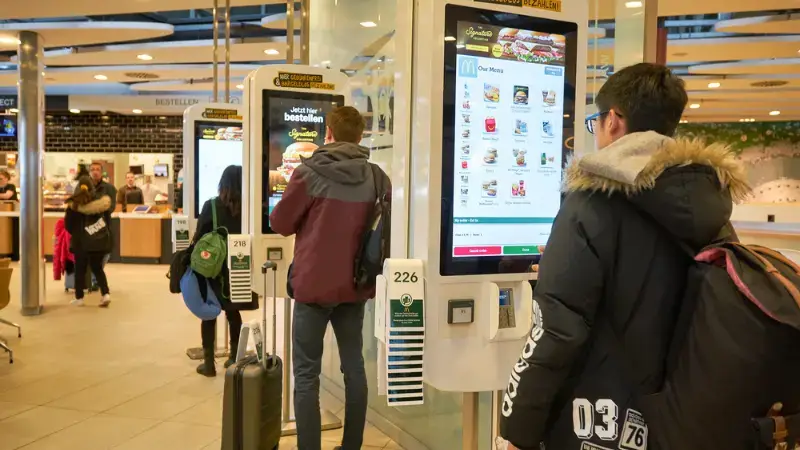
A self-service kiosk is a win-win for business owners. Here’s how;
- Lower Labor Dependence
Kiosks reduce the need for full-time staff to handle routine tasks. With hourly wages averaging $15–$18, a single kiosk can offset 30–40 hours of weekly staffing. McDonald’s reported labor savings of up to 8% per location after rolling out kiosks in high-traffic areas.
- Higher Service Throughput
A kiosk doesn’t slow down. During peak hours, it keeps the line moving. QSR Magazine found that kiosks increase order processing speed by 20–30%, which directly boosts revenue per hour.
- Service Quality Without Staff Variation
Every customer sees the same interface, the same options, and the same speed. Kiosks eliminate order entry mistakes, upsell consistently, and never forget to offer key add-ons.
- Smarter Business Decisions
Each transaction feeds valuable data into your system…what sells, when, and to whom. This allows you to optimize inventory, fine-tune pricing, and measure customer preferences across locations.
Customer Benefits (Speed, Control, and Convenience)

Self-service kiosks make customers’ lives easy. Here’s why;
- Shorter Wait Times
Nobody enjoys waiting in line, especially during lunch or after work. Kiosks cut line times by 40–50% in many retail and foodservice environments, giving your customers a faster in-and-out experience.
- Frictionless Checkout and Order Control
Customers feel more comfortable customizing orders or making decisions without pressure. In a Tillster survey, 65% of diners said they would visit a restaurant more often if self-ordering kiosks were available.
- Low-Contact, Private Interaction
Especially in healthcare or busy retail spaces, kiosks reduce the need for face-to-face interaction. This appeals to customers who prefer privacy or faster movement through crowded spaces.
What Industries Use Self-Service Kiosks Successfully?
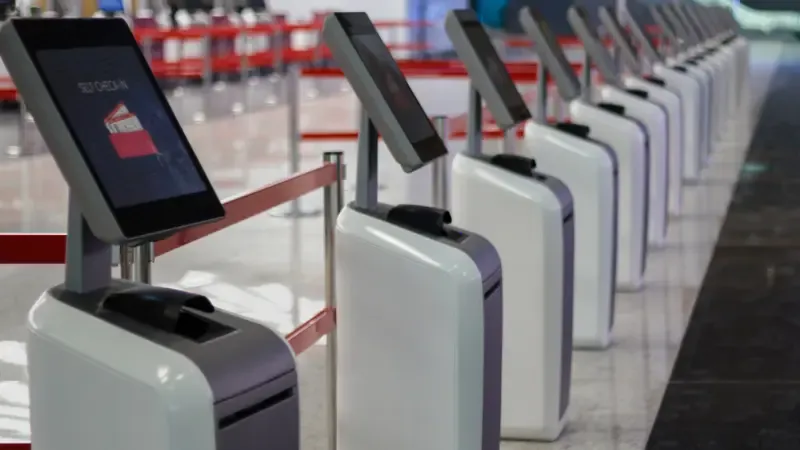
Self-service kiosks are not limited to retail…they’re being used in almost every service-heavy industry where time, accuracy, and customer flow matter.
Retail and Grocery Stores
Chains like Walmart and Target use self-checkout kiosks to move customers through faster, especially during peak hours. They reduce wait times and allow staff to focus on stocking or customer assistance instead of ringing up items.
Fast Food and Quick-Service Restaurants
McDonald’s, Panera, and Taco Bell use ordering kiosks to handle high-volume traffic. Customers place orders directly, which improves speed and reduces errors at the counter. Many restaurants also report higher average order values from kiosks due to consistent upsell prompts.
Healthcare Facilities
Clinics and hospitals use kiosks for patient check-ins, appointment confirmations, and form completion. This frees up front-desk staff and shortens lobby wait times without affecting service quality.
Hotels and Hospitality
Many hotels now use kiosks in the lobby for check-in, key card printing, and payment. It helps manage high check-in volumes and offers a faster option for repeat guests and business travelers.
Airports and Transit
Airlines and train stations use kiosks for check-in, boarding passes, and ticket purchases. These units cut down lines and help travelers who need fast, self-directed service.
Education and Government Offices
Schools, universities, and public buildings use kiosks to display directories, collect digital forms, and share service information. They reduce paperwork and keep foot traffic moving through high-use public areas.
Questions to Ask Before Buying a Self-Service Kiosk
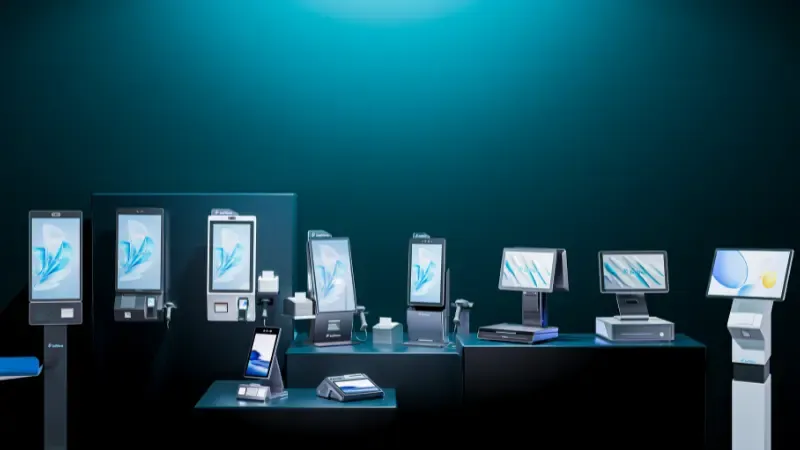
Not every kiosk fits every business. Before you invest, you need to think beyond the screen and look at how the system fits into your daily operations, environment, and future growth.
Key Questions to Help You Choose the Right Kiosk
| Question | Why It Matters |
|---|---|
| What type of kiosk suits my business? | Helps identify the right model: checkout, ordering, information, or ticketing |
| What is my budget for hardware & software? | Helps plan total cost and return on investment |
| How will the kiosk integrate with my systems? | Ensures POS, CRM, and inventory work together without extra manual effort |
| Do I need support & maintenance services? | Keeps the kiosk running long-term with minimal downtime |
| Will the kiosk be used indoors or outdoors? | Impacts screen brightness, casing durability, and weather protection |
| What payment types do I want to support? | Determines hardware needs: card reader, NFC, mobile wallet, or cash acceptor |
| How many users do I expect per day/week? | Helps size the system correctly to avoid delays or overload |
| Do I need to meet ADA or accessibility rules? | Ensures compliance and better user experience for all customers |
This short checklist can save you from choosing a system that doesn’t scale, doesn’t fit, or doesn’t deliver value after installation.
It’s worth spending time here before you spend the budget.
Info Kiosk Questions: What Do Users Commonly Ask?
Whether placed in a retail store, hospital, museum, or public space, information kiosks serve one core purpose: answer questions without involving staff. To work well, the kiosk must address the most common things people ask.

Common User Questions and Scenarios
“Where can I find [X]?”
In malls or hospitals, users often search for directions—“Where’s the cardiology wing?” or “Where’s Zara on this floor?”
A good kiosk shows maps, landmarks, and step-by-step directions.
“What does this product do?”
In retail, customers want specs, comparisons, or reviews. For example, “What’s the difference between this phone and the one next to it?”
Kiosks should provide side-by-side features and pricing.
“How do I check out or make a payment?”
In self-checkout setups, users may ask: “Do I scan here?” or “Can I pay with my phone?”
Clear on-screen prompts guide them through the process.
“Can I speak to someone?”
Not everything can be automated. Some users will want live help…especially older customers. A kiosk should offer a “Need Help?” button that alerts staff or opens a live chat.
Planning for these questions makes your kiosk useful and more functional.
How to Choose the Right Self-Service Kiosk for Your Business
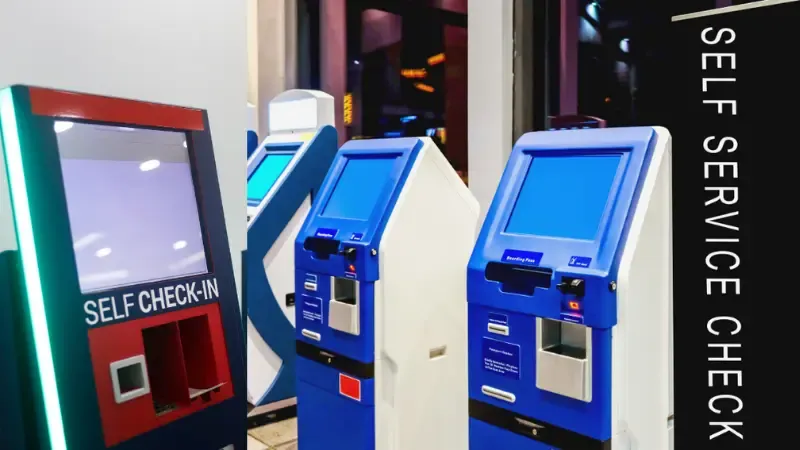
A kiosk solves the right problem most efficiently.
That’s why the best approach is to think through a few practical decisions before signing off on any system.
1. What Can You Automate Without Losing Personal Touch?
Start with this: which parts of your operation cause delays or bottlenecks but don’t require staff judgment?
If you’re losing time at checkout, a kiosk works. If customers get stuck on menus or forms, a digital interface can help. But if your business relies heavily on conversation or service upselling, a kiosk might only support…not replace…staff.
2. What Does Your Existing Tech Stack Look Like?
A kiosk that can’t “talk” to your POS or inventory system becomes an isolated tool. Check if the provider offers built-in integrations or APIs for your core software. This avoids future costs and delays.
3. Are You Ready for Rollout Logistics?
The buying decision doesn’t end with specs. You need to consider:
- Space: Where will the kiosk physically fit?
- Power and network: Will it require wired internet or a backup battery?
- Staff readiness: Who on your team will manage or troubleshoot it?
A well-matched kiosk fits into operations without creating friction—for staff, IT, or your customers.
Vendor Evaluation Checklist
| Evaluation Criteria | What to Look For |
|---|---|
| Industry Experience | Has the vendor deployed kiosks in your industry (e.g., retail, foodservice, healthcare)? |
| Hardware Customization | Can they adapt screen size, peripherals, or enclosures to fit your layout? |
| Software Integration | Do they offer POS, inventory, or CRM integrations out of the box or via API? |
| Support & Maintenance | Do they offer post-deployment support, warranty terms, and service-level agreements? |
| Deployment Timeline | How long will it take to manufacture, ship, and install the kiosk at your location(s)? |
| Pricing Transparency | Are hardware, software, and support costs clearly broken down with no hidden fees? |
| Client References | Can they share case studies or existing client contacts for reference checks? |
What’s Next for Self-Service Kiosks? Trends to Watch
Modern Kiosks are designed to personalize service, reduce friction, and lower long-term operating costs. Here’s what’s coming next;
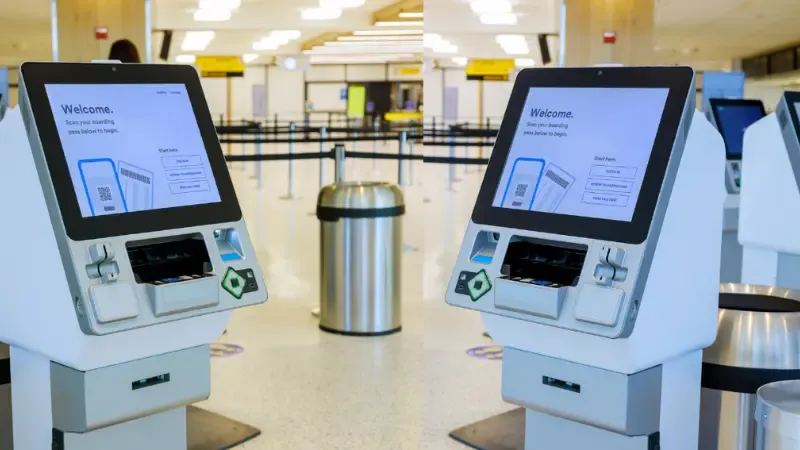
AI-Driven Personalization
Some kiosks can now recognize customer patterns—like past purchases or time of day—and adjust menus or suggestions to match. It’s a simple way to boost sales without extra staff.
Touchless Interfaces
Voice commands and hand gestures are being tested in places like hospitals and busy public areas. These touch-free options make kiosks more accessible and safer to use.
Mobile Wallet and Loyalty Integration
Modern kiosks increasingly support Apple Pay, Google Wallet, and custom loyalty programs. Smart Sight study shows that this allows for faster checkouts and better customer data capture across channels.
Low-Energy and Sustainable Designs
Newer kiosks use less power. Some even have motion sensors or low-energy displays to save electricity and reduce environmental impact.
These trends suggest that kiosks will soon play a larger role in customer engagement. And their usage will not be limited to transaction processing.
FAQs About Self-Service Kiosks
Can a kiosk work offline if my internet goes down?
Most kiosks have offline modes for limited functions, but full payment and data sync usually require a live internet connection.
How long does it take to fully deploy a kiosk system?
From order to deployment, it can take anywhere from 3 to 10 weeks depending on customization, shipping, and installation schedules.
Do kiosks work with older POS systems?
Some do, but integration may require middleware or a partial system upgrade. Ask your vendor about compatibility.
What maintenance do kiosks need?
Routine software updates, screen cleaning, and occasional hardware checks. Many vendors offer remote monitoring and diagnostics.
How often does kiosk software need updating?
Critical security updates are usually pushed monthly or quarterly. Feature upgrades may be scheduled annually or by request.
Can I change the content or UI myself?
Yes, most providers offer a CMS (content management system) that lets you update screens, menu items, or messaging remotely.
Are kiosks ADA compliant by default?
Not always. You’ll need to request models with adjustable height, audio prompts, and tactile input features to meet accessibility guidelines.
What if a customer walks away mid-transaction?
Most kiosks time out and reset automatically. Some can log partial data or send a notification for staff review.
Can I use the same kiosk for multiple services?
Yes, many kiosks can be configured to handle payments, check-ins, ticketing, or surveys on the same screen.
Is training required for my staff to use the kiosk?
Minimal training is needed…mostly for troubleshooting, restocking printers, or helping customers during early adoption.
Conclusion
If you’re still managing every transaction manually, you’re leaving value on the table. The gap between businesses that automate and those that don’t keeps getting wider.
Kiosks are quickly becoming the baseline.
Whether you’re running one location or scaling across regions, the right kiosk setup can streamline operations and free up your team to focus on higher-value work.
Ready to Invest in a Self-Service Kiosk?
Ready to take the next step? Explore SwiftForce kiosk solutions designed around your goals, space, and budget. Or get in touch with our team for expert guidance on the best-fit solution for your business.



